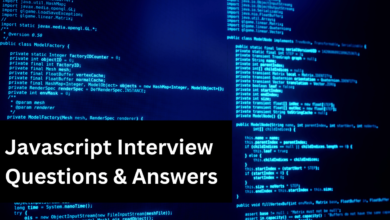20+ Most Asked Flask Interview Questions

If you are looking for Most Asked Flask Interview Questions you are at the right place. Here in this article, we are going to share 20+ most asked Flask Interview Questions with answers which will help you to qualify your Interview.
Flask is a micro web framework written in Python. It is classified as a microframework because it does not require particular tools or libraries. It has no database abstraction layer, form validation, or any other components where pre-existing third-party libraries provide common functions.
Most Asked Flask Interview Questions
1.) What are the main features that are available in Flask Python?
Flask Python is one of the most modern frameworks for Python and is utilized in the creation of web-based applications with the following functions:
- Flask includes an integrated development server along with a speedy debugger
- It also includes the necessary support to conduct unit tests.
- It is equipped with sending requests to the rest of the world
- Includes Jinja2 templating technology.
- Flask allows secure cookies that are secure i.e. sessions on the client-side
- Also comes with the WSGI 1.0 fully compliant feature.
- It is built on Unicode.
- Python Flask is extensively documented.
2.) Which are the benefits of Flask Python?
Flask Python is packed with all the benefits of Python and also some other advantages of it include:
Flask’s design is light and flexible. It is therefore simple to convert it into a web-based application or framework if one requires only a few extensions, without weighing too much.
Flask is not dependent on ORMs: i.e. users can connect their preferred ORM such as SqlAlchemy. The fundamental premise of API is beautifully shaped and is woven into a coherent.
The documentation for Flask is thorough, with plenty of examples, and is organized. Users can also try several sample applications to understand the true feel of Flask.
It is very simple to implement Flask in production since Flask is 100 percent WSGI 1.0 compatible
Flask is able to manage HTTP requests easily, with the aid of its functions
It’s highly adaptable. Its configuration is also more flexible than Django and gives its users the ability to create a multitude of solutions for every product they’ll need.
3.) What is FlaskWTF and what are their strengths?
Flask WTF can be used to provide an easy Integration with WTForms. The features that are included in Flask WTF include:
- Integration with web forms
- It is a very secure form since it includes a CSRF token
- Protects you from CSRF worldwide
- Internationalization integration is a part of the package.
- Also, it has Recaptcha support
- It contains File uploads that closely relate to Flask Uploads
4.) What is the length of time an identifier lasts in Flask Python?
In the language of Flask Python, an identifier is a string of any length. Additionally, there are specific rules that the users must adhere to when naming an identifier.
It should start with a letter or an underscore, or be derived from A-Z or A-Z.
The remaining name of the identifier could include anything from A-Z, a-z, 9, or _.
Flask Python is case-sensitive, which means the program will handle upper lettering and letters in lower cases in a different way.
There are some words that are reserved in Python called keywords and cannot be used for identifiers. Some of these can be found below:
and as well as or, if not true and, del, lastly in, or test, claim, and so on it is passed by, break, and, if, from lambda, print with class, with the exception of global and none raise, yield continues, execute, and If it is not local return
- Terraform Interview Questions & Answers For Interview Preparation
- 12 Top Autosar Interview Questions That Can Help To Crack Your Interview
- 30+ Most Asked IC Engine Interview Questions To Crack Your Interview
- Policy Bazaar Interview Questions & Answers That Will Help You To Crack Your Interview
5) What are the HTTP methods offered by Python Flask?
HTTP methods can be used to retrieve information from URLs:
- GET It is a GET technique by which one sends data to a server without encryption.
- HEAD: HEAD is comparable to GET however it does not have a response body.
- POST It is important to note that the POST server doesn’t cache data from the HTML form data it transmits
- PUT is the method by which uploaded content replaces the current representations of data for the resource to be targeted.
- DELETE: This procedure eliminates the representation of the resource to be deleted which is implied by the URL.
6.) What is the meaning of the templates engine in Flask Python?
When the website is created by users, they are often faced with the challenge to keep the design of the site consistent. Sometimes, the website’s users are required to write more than once the same content if they attempt to alter the design of these websites.
If the website has just a few pages, changing the style can take the time it takes to do, which is manageable. If they’ve got many pages (for instance, the inventory of merchandise available in a shopping mall) the task can become repetitive and stressful.
With templates, the user can define a basic layout for all of their pages, and specify which elements should be modified often. By using templates, the users can set their header once and maintain it in place across all pages on their website and, if they want to alter their header it will be necessary to change it at one point.
Utilizing a template engine can help users save a quantity of time not just when they design their app but also when making updates and maintaining it.
7.) How can I tell the most significant distinctions in Pyramid as well as Flask?
Flask can be described as a micro framework specifically designed for small applications, that have fewer needs. Flask’s users must use external libraries. Flask is always available for use.
Pyramid On the contrary is designed for large-scale applications because it provides flexibility, and lets developers choose the best features for their project. The developer has the option of choosing the type of database, the URL templating structure, and many more. Pyramid can therefore be heavily configurable.
8.) Define how one can make database connections using Flask?
Flask framework permits its users to access databases in three ways. These are:
before_request()-These connections are called before making a request and no arguments are passed
after_request() after_request() is created after the request and the result is sent directly to the user.
teardown_request() This connection is used in situations in which an exception is raised and the response is not certain to be received. They also are called following the process of creating the response. They cannot alter the request, and their meanings are not able to be not considered.
9) What can a request context be made using Flask Python?
A request profile created in Flask Python can be created using two methods:
- It can be used on its own or automatically after receiving an inquiry from the system
- Manually that is by calling app.test_request_context
10.) Give an example of how you can enable debugging to Flask Python?
Two ways through which people can enable debugging within Flask. The two methods are as follows:
In setting the flag to the application object
Bypassing the flag is an option. If the user has enabled debug support, then the server will load it again when the code changes and the user won’t need to start over after every change made to the code.
11) What exactly do you mean by the thread-local property that is in Flask Python?
Flask Python utilizes Thread Local objects to ensure that the user isn’t required to transfer objects from one function to the next function in a request, to ensure that the thread is secure. This technique is very useful however it requires a complete context for the request to be used for dependency injection or for trying to reuse code. This makes use of a value that is incorporated into the request.
Flask Python can run all kinds of database-powered software, including RDBS. These systems require the creation of a schema. This also needs to connect with the schema.sql file to the sqlite3 command. Therefore, users must install the sqlite3 command if they intend to create or launch the database using Flask Python.
12) What is the best way to implement one-access sessions be implemented in Flask Python? Indicate the possibility that Flask Python is an MVC model.
Sessions within Flask Python is a feature that allows you to store the information that is passed from one request to the next. A flask application uses a certificated cookie, which allows users can examine the content in the session, and edit the session. Users can also alter the session only if it is equipped with the secret key, which is known as the Flask.secret_key. Flask is a tiny version of the Python framework, and it is similar to it is the MVC framework. This means that MVC is the perfect fit for Flask.
13) What is meant by a “decorator”? Give a few PDB commands and their applications.
A decorator can be described as an application that adds function to another function, without altering the function. This wraps the functionality in order to give it some added functionality. it. Some PDB commands include is a way to add an endpoint:
The execution is resumed.
- It debugs step-by-stage
- It then moves to the next line
- It contains the source code
The printer prints an expression
14) What exactly do you mean by NumPy? Does it have more value than an array?
NumPy can be described as one of the Flask Python packages which have established its name in the age that is known as scientific computing. It is a program that deals with massive data volumes and includes a powerful N-dimensional array object as well as an array of sophisticated functions.
A NumPy array is far superior to lists. Here are some ways to do it:
NumPy is smaller than the list.
NumPy is more useful than the other options.
Numpy is more effective than List.
It’s easier to write and read items using NumPy.
15.) What exactly do you think about pickling and unpickling?
To create a portable and serialized representation that are serialized representations of Python objects, we’ve got the program called pickle. It takes a Python object (basically everything in Python is an object) and converts it to the string type followed by the dump () function to dump it into an archive file. We refer to this as pickling.
However, removing objects from stored strings is referred to as unpickling.
16) How do we manage memory within Flask Python?
Flask Python is a collection of private heap spaces which hold all data structures and objects together. It is not accessible to programmers. It’s the job of the interpreter. In the core API, users have access to a few applications. Flask Python memory manager controls the allocation of memory. In addition, an integrated garbage collector is included that recycles memory that is not used and makes it available for heap space.
17) Discuss how you can create a massive Flask application?
To build a huge flask, one has to adhere to these instructions:
Join the function, and transfer them to different formats, provided that users are sure that the files will be imported once the application starts
Use blueprints to assign views to categories like auth, backend, profile, etc.
You can then use it to hide the Werkzeug URL map, and register functions using the central URL map.
18.) What are the prerequisites to build the Database for the database Flask Python?
Flask Python is compatible with all types of database-powered applications, such as RDBS. These systems require the creation of a schema. This also needs to connect with the schema.sql file to a sqlite3 command. Therefore, users must install the sqlite3 command when they intend to create or launch the database using Flask Python.







